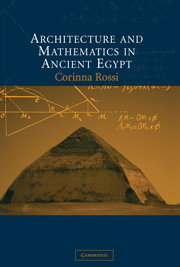Book contents
- Frontmatter
- Contents
- List of illustrations
- List of tables
- Preface
- Acknowledgments
- List of abbreviations
- Part I Proportions in ancient Egyptian architecture
- Part I Ancient Egyptian sources: construction and representation of space
- Part III The geometry of pyramids
- Introduction to Part III: Combining the knowledge
- 5 Symbolic shape and constructional problems
- 6 The proportions of pyramids
- 7 Pyramids and triangles
- Conclusion to Part III: Interpreting the slope of pyramids
- An overview
- Appendix: List of Old and Middle Kingdom true pyramids
- Bibliography
- Index
6 - The proportions of pyramids
Published online by Cambridge University Press: 27 February 2010
- Frontmatter
- Contents
- List of illustrations
- List of tables
- Preface
- Acknowledgments
- List of abbreviations
- Part I Proportions in ancient Egyptian architecture
- Part I Ancient Egyptian sources: construction and representation of space
- Part III The geometry of pyramids
- Introduction to Part III: Combining the knowledge
- 5 Symbolic shape and constructional problems
- 6 The proportions of pyramids
- 7 Pyramids and triangles
- Conclusion to Part III: Interpreting the slope of pyramids
- An overview
- Appendix: List of Old and Middle Kingdom true pyramids
- Bibliography
- Index
Summary
Analysing true pyramids
Numerological theories
It is virtually impossible to mention all of the theories that have been suggested to explain the geometry of Egyptian pyramids. Many of them are based on more or less imaginative interpretations. At best, they are incorrect simply because they are based on our modern mathematics, with little respect for the ancient Egyptian system, but in the worst cases no field of human knowledge has been left untouched by those who aim to find hidden meanings in these ancient monuments.
The pyramid of Khufu, being the largest and the most famous (and, in fact, often simply called the ‘Great Pyramid’), has especially inspired complicated mathematical interpretations. They are usually based on the assumption that the pyramid was planned and built using mathematical principles such as π (the ratio between diameter and circumference in a circle) and φ (the number of the Golden Section). Useful summaries of the history of the most famous mathematical theories have been published by Jean-Philippe Lauer and Franco Cimmino, among others. In particular, Roger Herz-Fischler has listed all of the theories suggested so far on the pyramid of Khufu alone.
Information
- Type
- Chapter
- Information
- Architecture and Mathematics in Ancient Egypt , pp. 200 - 211Publisher: Cambridge University PressPrint publication year: 2004
